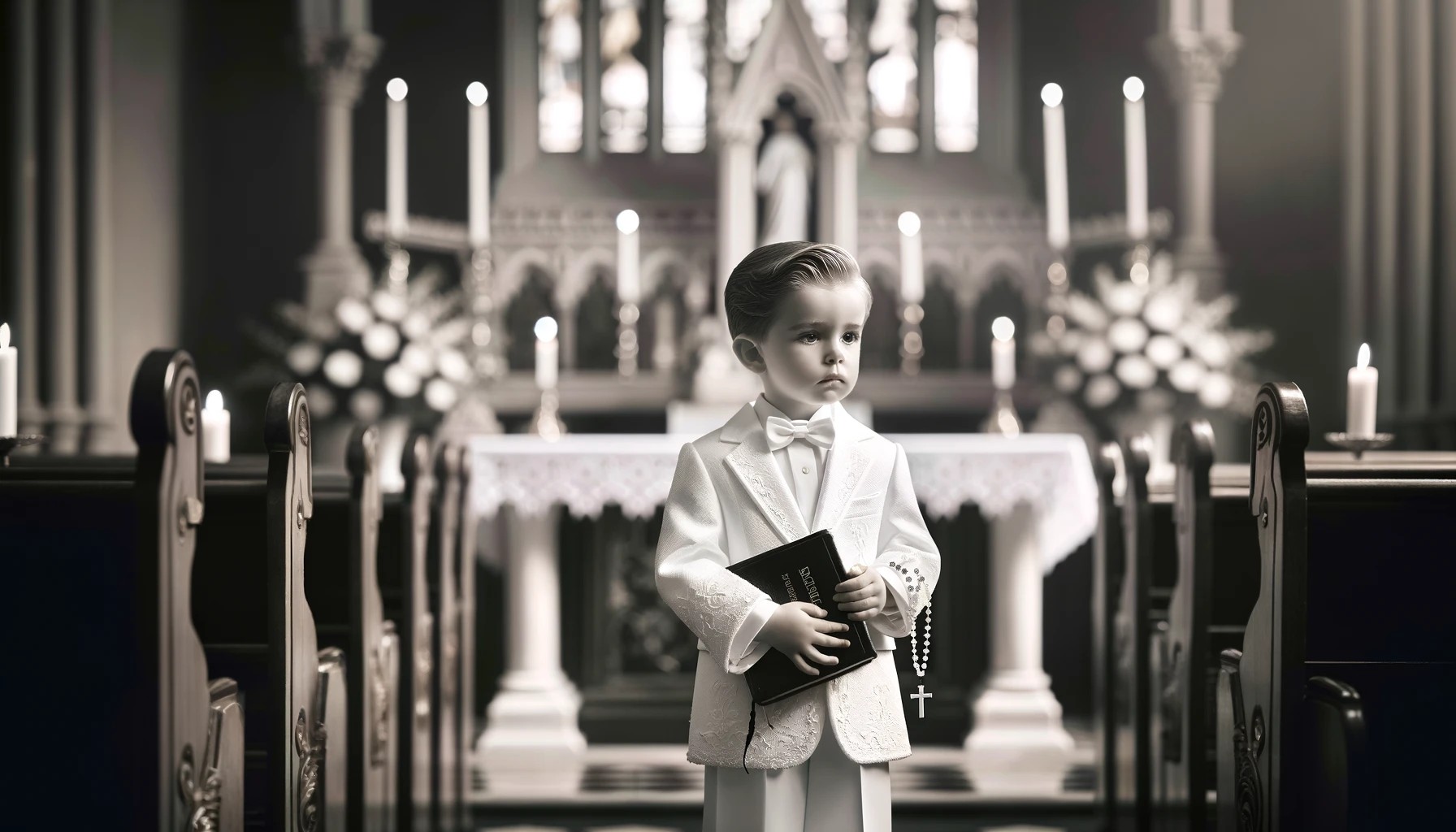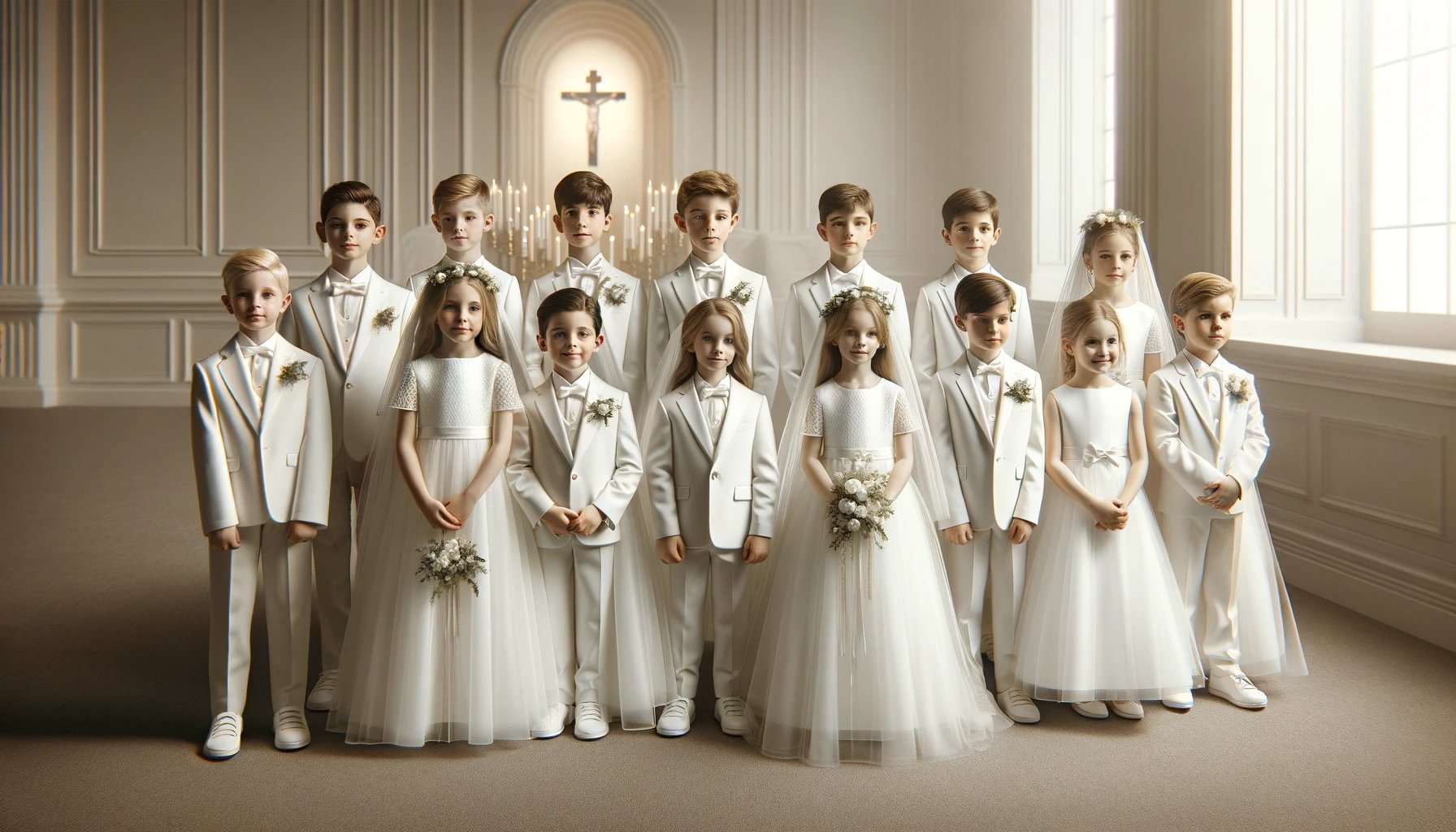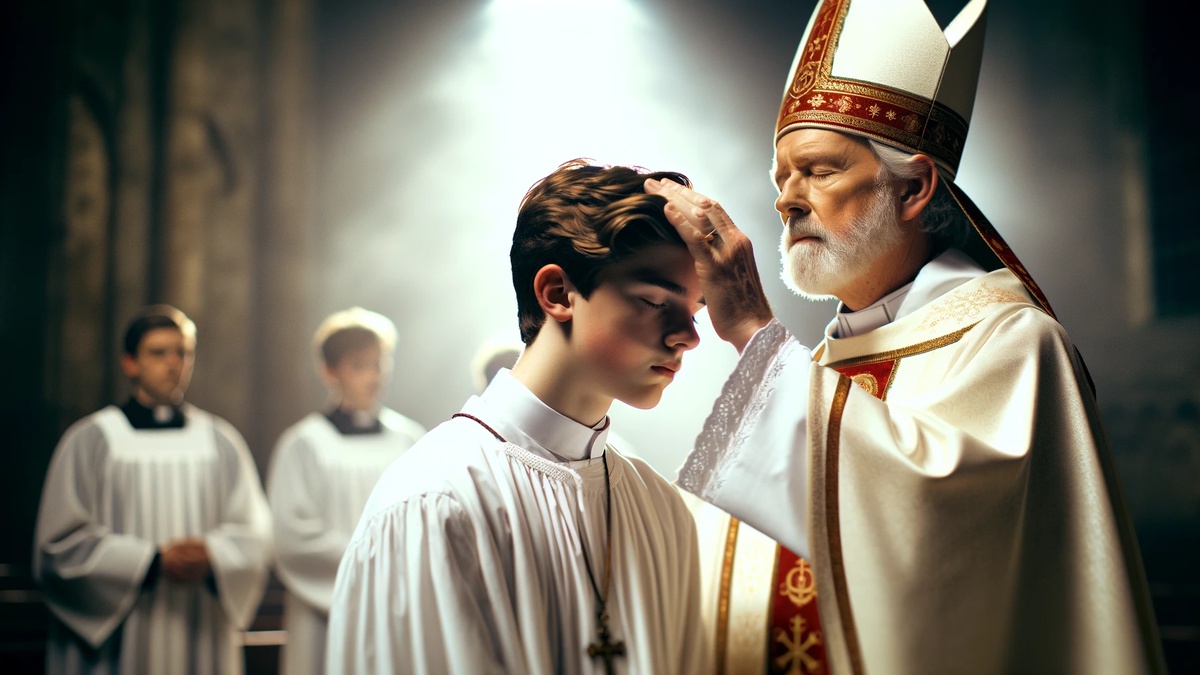Home>Theology and Spirituality>What Do You Need For Your First Communion


Theology and Spirituality
What Do You Need For Your First Communion
Published: February 19, 2024
Peter Smith, Editorial Director at Christian.net, combines deep insights into faith, politics, and culture to lead content creation that resonates widely. Awarded for his contributions to religious discourse, he previously headed a major organization for religious communicators, enhancing dialogue on faith's societal impacts.
Prepare for your child's first communion with our comprehensive guide. Find everything you need for this special occasion at our theology and spirituality store.
(Many of the links in this article redirect to a specific reviewed product. Your purchase of these products through affiliate links helps to generate commission for Christian.net, at no extra cost. Learn more)
Table of Contents
Introduction
The First Communion is a significant milestone in the lives of young Christians, marking their initiation into the sacrament of the Eucharist. It is a sacred and joyous occasion that holds deep spiritual significance for both the child and their family. This special event symbolizes the child's growing understanding of their faith and their readiness to partake in the body and blood of Christ.
The journey towards First Communion is filled with anticipation, preparation, and reverence. Families and communities come together to support and guide the children as they embark on this spiritual rite of passage. From religious instruction to selecting the perfect attire, every aspect of the First Communion is carefully considered to ensure a meaningful and memorable experience for the child.
As we delve into the various elements that contribute to a child's First Communion, it becomes evident that this occasion is not only a personal milestone but also a communal celebration of faith and unity. The significance of this event extends beyond the individual, encompassing the entire faith community and reinforcing the bonds of spirituality and tradition.
In the following sections, we will explore the multifaceted aspects of preparing for and celebrating a First Communion. From the religious significance to the practical considerations, each component plays a vital role in honoring this sacred tradition and creating cherished memories that will endure for a lifetime. Join us as we embark on a journey through the spiritual and cultural dimensions of the First Communion, delving into its profound meaning and the elements that make it a truly momentous occasion.
Read more: What Do Godparents Do At First Communion
The Importance of First Communion
The First Communion holds profound significance in the life of a young Christian, signifying a pivotal moment in their spiritual journey. This sacred rite marks the child's initiation into the sacrament of the Eucharist, symbolizing their acceptance into the community of believers and their commitment to the teachings of Christ. It is a deeply meaningful event that not only shapes the child's understanding of faith but also fosters a sense of belonging within the religious community.
At the heart of the First Communion is the belief in the real presence of Jesus Christ in the consecrated bread and wine. Through this sacrament, participants are united with Christ and with one another, reinforcing the bonds of faith and fellowship. The act of receiving the Eucharist is a profound expression of devotion and a tangible way for children to connect with the teachings of Jesus, fostering a deeper understanding of the spiritual nourishment that comes from partaking in the body and blood of Christ.
Furthermore, the First Communion serves as a foundational step in the child's religious education, providing them with a solid grounding in the rituals and traditions of the faith. It offers an opportunity for young believers to deepen their understanding of the Christian doctrine and to cultivate a personal relationship with God. The experience of preparing for and receiving First Communion instills in children a sense of reverence, gratitude, and humility, nurturing their spiritual growth and shaping their moral compass.
Beyond its individual significance, the First Communion also holds communal importance, strengthening the bonds within the faith community. Families, friends, and fellow parishioners come together to celebrate this milestone, offering support and encouragement to the children as they take this momentous step in their faith journey. The shared experience of witnessing the children partake in the Eucharist fosters a sense of unity and solidarity, reinforcing the interconnectedness of the community and the enduring traditions that bind them together.
In essence, the First Communion is a sacred and joyous occasion that carries profound spiritual, educational, and communal significance. It marks the beginning of a lifelong journey of faith and serves as a testament to the enduring traditions and teachings that continue to shape and enrich the lives of believers. As children take their first steps towards receiving the Eucharist, they embark on a transformative path that nurtures their spiritual development and strengthens their connection to the divine and the community of faith.
Religious Preparation
Religious preparation for First Communion is a fundamental aspect of the journey towards this sacred milestone. It involves a comprehensive process of spiritual education and formation, equipping children with the knowledge, understanding, and reverence necessary to participate in the Eucharist. The religious preparation for First Communion encompasses several key elements that are essential in nurturing the faith and spiritual growth of the young participants.
Catechesis and Instruction
Central to religious preparation is catechesis, which involves systematic instruction in the teachings of the Christian faith. Children receive guidance on the significance of the Eucharist, the meaning of the sacrament, and the rituals associated with receiving communion. Catechists play a crucial role in imparting religious education, ensuring that children comprehend the profound spiritual significance of the Eucharist and the responsibilities that come with receiving it.
Sacramental Readiness
Religious preparation also focuses on assessing the child's readiness to receive the Eucharist. This involves discerning the child's understanding of the sacrament, their ability to participate reverently, and their willingness to embrace the spiritual significance of communion. Through discussions, reflections, and guidance, children are encouraged to internalize the teachings of the faith and express their readiness to partake in the Eucharist.
Read more: What Do You Do In Your First Communion
Spiritual Formation
In addition to cognitive understanding, religious preparation emphasizes the spiritual formation of the children. It involves nurturing their relationship with God, fostering a sense of reverence, and cultivating a spirit of prayer and reflection. Through age-appropriate spiritual exercises, children are encouraged to deepen their connection to the divine and develop a personal understanding of their faith, preparing them to approach the Eucharist with humility and devotion.
Family Involvement
Religious preparation for First Communion extends beyond the classroom, involving the active participation of families in the process. Parents and guardians play a vital role in supporting their children's religious education, reinforcing the teachings at home, and engaging in meaningful discussions about the significance of the Eucharist. Family involvement creates a holistic approach to religious preparation, integrating the values and teachings of the faith into the fabric of daily life.
Community Engagement
The broader faith community also contributes to the religious preparation for First Communion. Children participate in communal activities, attend Mass, and engage in rituals that deepen their sense of belonging within the faith community. This communal engagement fosters a spirit of unity and solidarity, reinforcing the significance of the Eucharist within the context of the larger religious community.
In essence, religious preparation for First Communion encompasses a multifaceted approach that combines instruction, spiritual formation, family involvement, and community engagement. It is a comprehensive process that seeks to instill in children a deep understanding of the Eucharist, nurture their spiritual growth, and integrate them into the fabric of the faith community. Through this preparation, children are equipped with the knowledge, reverence, and spiritual readiness to embark on this sacred journey of receiving the body and blood of Christ for the first time.
Attire and Accessories
The attire and accessories worn during a First Communion hold special significance, symbolizing the solemnity and reverence of the occasion. The attire chosen for this sacred event reflects the spiritual importance of the Eucharist and the cultural traditions associated with the First Communion ceremony. From traditional garments to meaningful accessories, each element contributes to the overall significance and beauty of the celebration.
Read more: What Do Parents Wear For First Communion
Traditional Attire
The traditional attire for First Communion varies across different cultures and regions, often reflecting the customs and practices of the faith community. For girls, a white dress is a customary choice, symbolizing purity and innocence. The dress is often adorned with delicate lace, embroidery, or other embellishments, adding a touch of elegance and grace to the ensemble. Additionally, a veil or headpiece is often worn as a symbol of reverence and modesty, complementing the overall attire with a sense of solemnity and tradition.
Boys typically wear a suit or formal attire in keeping with the dignified nature of the occasion. A crisp white shirt, tie, and tailored suit convey a sense of reverence and respect, underscoring the significance of the sacrament. The traditional attire for boys mirrors the solemnity of the event and reflects the cultural customs associated with the First Communion ceremony.
Meaningful Accessories
In addition to the attire, certain accessories hold special significance during First Communion. For girls, a delicate cross necklace or bracelet serves as a meaningful accessory, symbolizing faith and devotion. The cross, a powerful emblem of Christian belief, serves as a constant reminder of the spiritual significance of the Eucharist and the enduring presence of Christ in their lives. Similarly, boys may wear a cross necklace or a tie pin, embracing the symbolism of the cross and its profound significance within the Christian faith.
A prayer book or rosary is another cherished accessory often carried during First Communion. These items serve as reminders of the importance of prayer and spiritual reflection, encouraging children to deepen their connection to their faith and the teachings of the Church. The prayer book or rosary becomes a treasured keepsake, representing the child's commitment to their spiritual journey and the enduring significance of the sacrament of the Eucharist.
Personal Touches
While adhering to tradition, many families also incorporate personal touches into the attire and accessories for First Communion. Handcrafted details, heirloom jewelry, or custom embroidery can infuse the attire with sentimental value, creating a unique and meaningful ensemble that reflects the child's individuality and family heritage. These personal touches add depth and warmth to the attire, underscoring the personal significance of the occasion and creating lasting memories for the child and their loved ones.
In essence, the attire and accessories for First Communion embody the spiritual and cultural significance of the sacrament, reflecting the solemnity, reverence, and personal meaning of this milestone event. From traditional garments to meaningful accessories, each element contributes to the beauty and significance of the celebration, honoring the child's initiation into the sacrament of the Eucharist with grace, dignity, and heartfelt symbolism.
Ceremony and Celebration
The ceremony and celebration of a First Communion are imbued with profound spiritual significance and cultural traditions, creating a memorable and joyous occasion that honors the child's initiation into the sacrament of the Eucharist. The culmination of religious preparation and anticipation leads to a ceremonial event that is rich in symbolism, reverence, and communal celebration.
Read more: What Do Godparents Give For First Communion?
Preparation and Decor
Prior to the ceremony, meticulous preparations are made to create a sacred and welcoming environment. The church or place of worship is adorned with floral arrangements, candles, and symbolic decorations, evoking a sense of reverence and beauty. The altar, where the Eucharist will be celebrated, is adorned with care, reflecting the sanctity of the occasion and the importance of the sacrament.
Procession and Rituals
The First Communion ceremony often begins with a solemn procession, as the children, dressed in their traditional attire, make their way to the altar accompanied by clergy, family members, and fellow parishioners. This symbolic journey signifies the children's readiness to partake in the Eucharist and their entry into the faith community. Rituals such as the presentation of gifts, prayers of thanksgiving, and the blessing of the children further enrich the ceremonial experience, underscoring the spiritual significance of the event.
The Eucharistic Celebration
Central to the First Communion ceremony is the Eucharistic celebration, where the children receive the body and blood of Christ for the first time. This sacred moment is marked by profound reverence and joy, as the children approach the altar to partake in the sacrament. The act of receiving the Eucharist symbolizes their union with Christ and the community of believers, fostering a sense of spiritual nourishment and unity.
Communal Celebration
Following the Eucharistic celebration, the First Communion is often followed by a communal gathering or reception, where families, friends, and fellow parishioners come together to celebrate this momentous occasion. Festive meals, shared laughter, and expressions of joy create a warm and inclusive atmosphere, underscoring the communal nature of the celebration. This gathering serves as a testament to the support and love extended to the children as they embark on this significant step in their faith journey.
In essence, the ceremony and celebration of a First Communion are a harmonious blend of spiritual reverence and communal joy, marking a pivotal moment in the lives of young believers. The ceremonial rituals, the solemnity of the Eucharistic celebration, and the communal festivities all contribute to an event that is both deeply meaningful and joyously celebratory, creating cherished memories that resonate with spiritual and cultural significance.
Read more: What Do You Say For A First Communion
Conclusion
The First Communion represents a profound and transformative milestone in the lives of young Christians, signifying their initiation into the sacrament of the Eucharist and marking a significant step in their spiritual journey. This sacred event holds deep religious, cultural, and communal significance, shaping the faith and identity of the children and fostering a sense of unity within the religious community.
As children embark on the path towards First Communion, they undergo a comprehensive process of religious preparation, receiving instruction, spiritual formation, and communal support to deepen their understanding of the Eucharist and their readiness to partake in this sacred sacrament. The religious preparation not only equips them with the knowledge and reverence necessary for the Eucharist but also nurtures their spiritual growth and strengthens their connection to the faith community.
The attire and accessories worn during the First Communion ceremony symbolize the solemnity and reverence of the occasion, reflecting the cultural traditions and spiritual significance of the sacrament. From traditional garments to meaningful accessories, each element contributes to the beauty and significance of the celebration, honoring the child's initiation into the sacrament of the Eucharist with grace, dignity, and heartfelt symbolism.
The ceremony and celebration of First Communion are rich in symbolism, reverence, and communal joy, creating a memorable and spiritually enriching experience for the children and their families. The culmination of religious preparation and anticipation leads to a ceremonial event that embodies the profound spiritual significance of the Eucharist and the communal celebration of faith and unity.
In essence, the First Communion is a testament to the enduring traditions and teachings that continue to shape and enrich the lives of believers. It serves as a foundational step in the children's religious education, fostering a deeper understanding of the Christian doctrine and cultivating a personal relationship with God. The communal celebration of this sacred event reinforces the bonds within the faith community, creating a sense of unity and solidarity that extends beyond the individual participants.
As children take their first steps towards receiving the Eucharist, they embark on a transformative path that nurtures their spiritual development and strengthens their connection to the divine and the community of faith. The First Communion is not only a personal milestone but also a communal celebration of faith, unity, and the enduring traditions that bind the community together.











